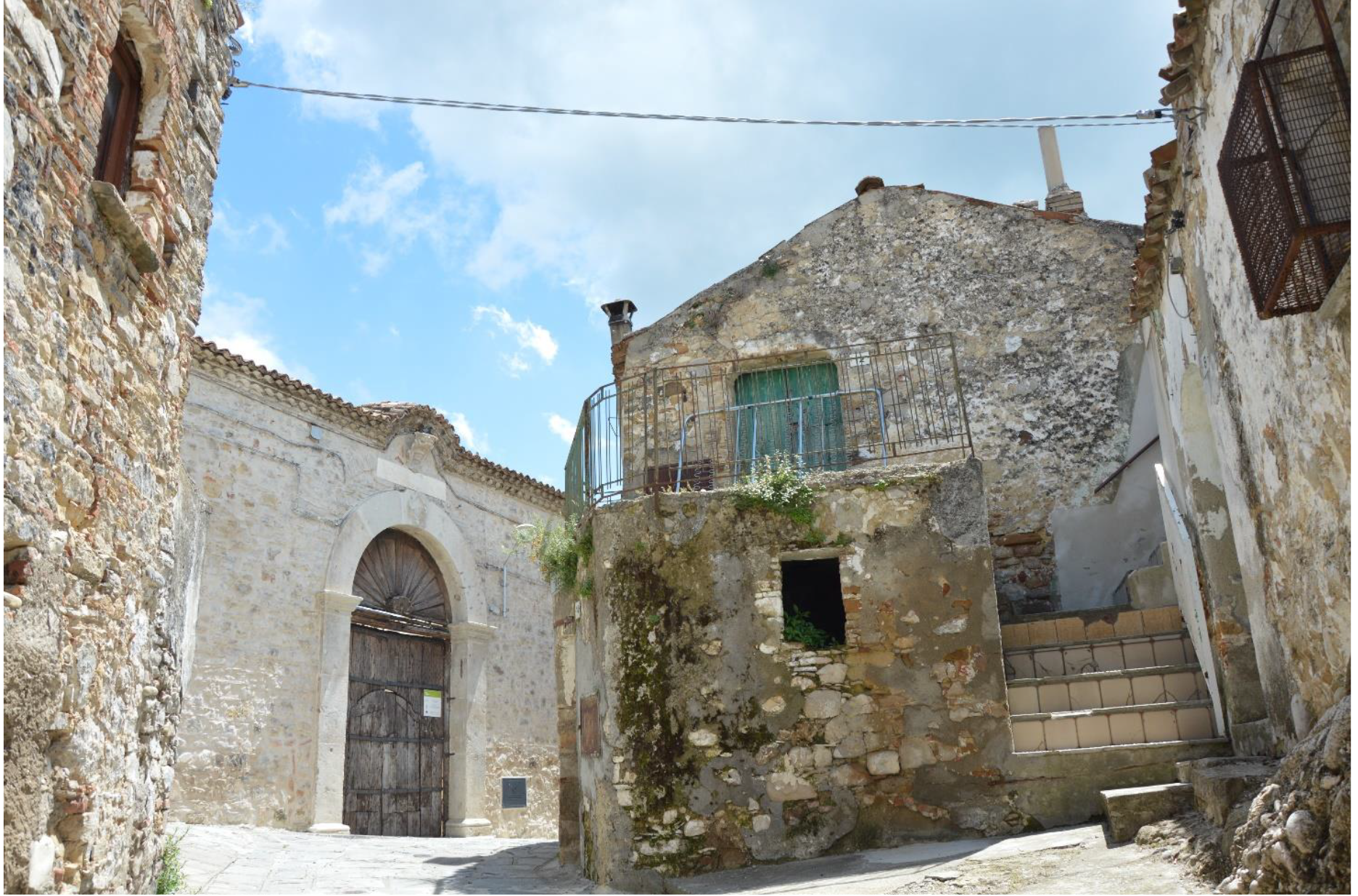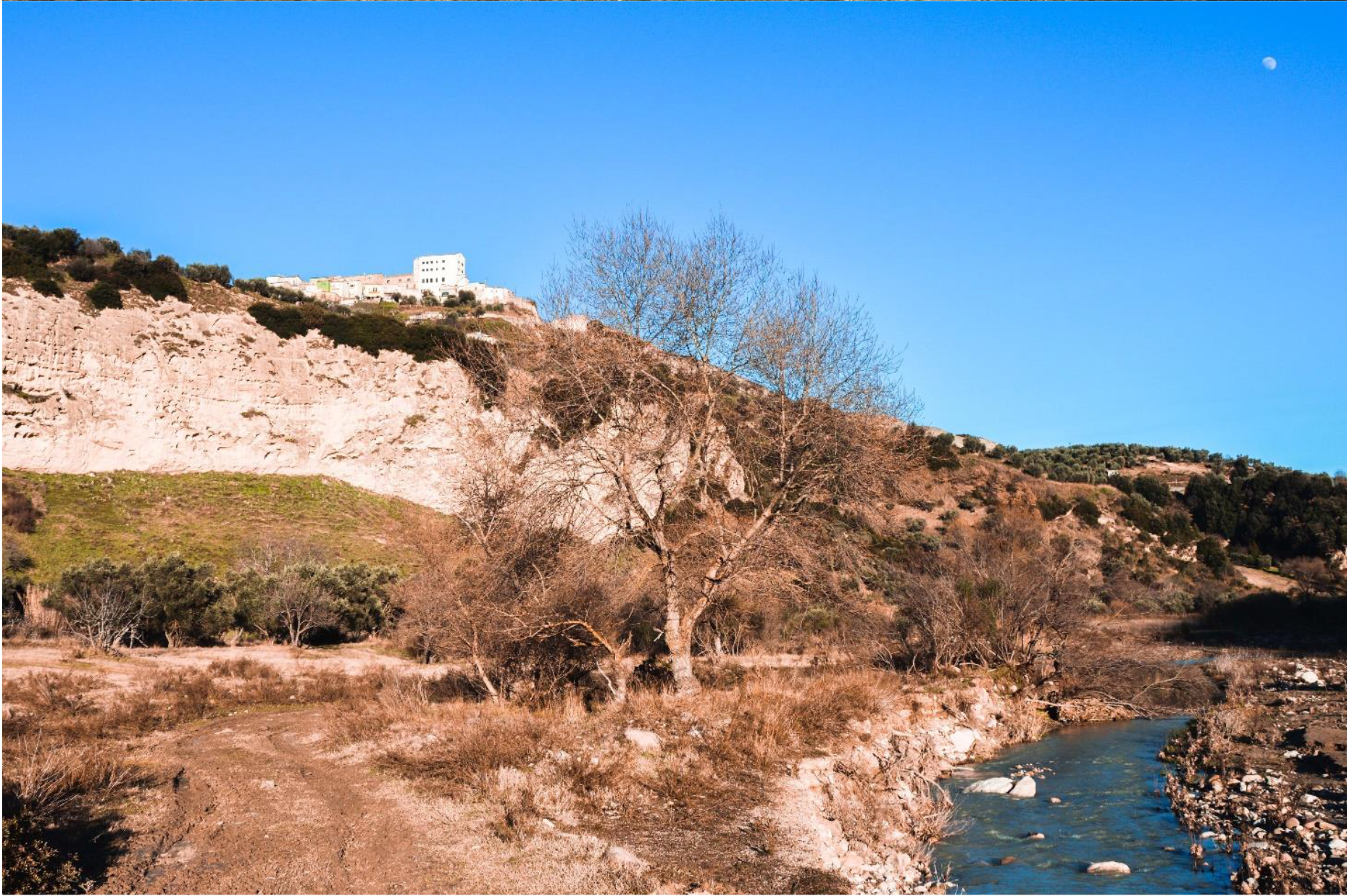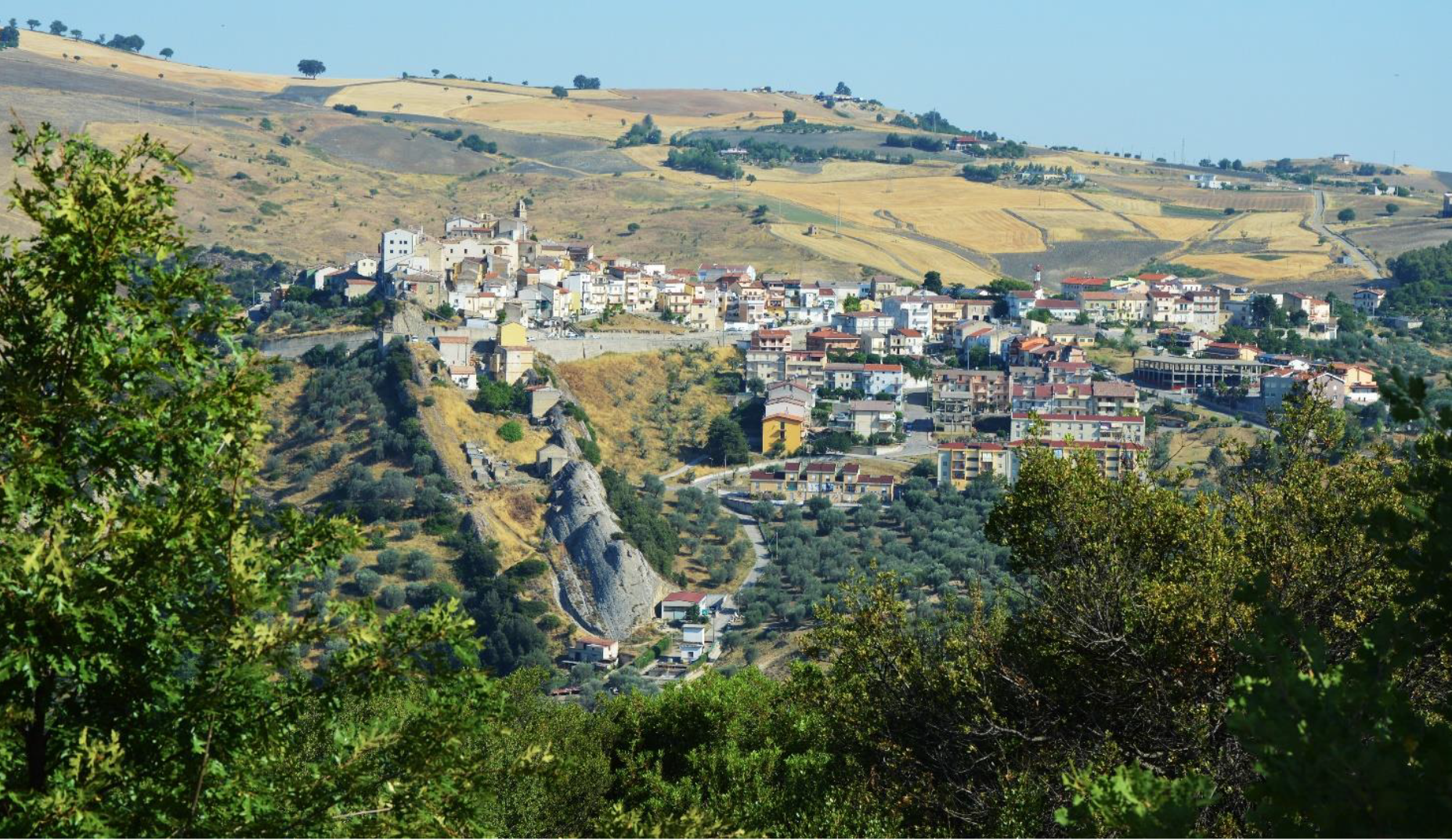A picturesque landscape surrounds the town of Garaguso that can be seen from the hills high above the Salandrella-Cavone stream. The origins of Garaguso go back to the 6th century B.C. as proven by the archaeological finds from the Ancient Greek era such as a small marble temple (a one and only worldwide) and the sculpture of the goddess Persephone in a sitting position. The original town was destroyed by the earthquake in 1694 and rebuilt by the Revertera, a noble family from Salandra.

NOT TO BE MISSED
Garaguso is situated in the heart of the hilly area around Matera with a wealth of landscapes to be admired. The Salandrella valley, the House of Revertera’s olive groves which can boast a number of monumental age-old olive trees, the woods overlooking the banks of the stream – these are but a few of the interesting places for nature lovers. The local cultural heritage boasts an 18th-century hunting residence – Palazzo Revertera (Revertera’s stately home)- in the town centre. The rudimentary primitive church of San Nicola di Myra (St. Nicholas of Myra) houses a valuable fresco depicting the Pietà dating from 1581. Palazzo Moles (Moles’ stately home), dominating what is now Piazza Europa, has origins going back to the 1700s.
FOOD EXCELLENCE
One of the area’s most valuable products is undoubtedly its extra virgin olive oil. Among the traditional local dishes is “a pàstural “made with lamb seasoned with vegetables, herbs and chilli and stewed very slowly. There are also excellent sausages such as home-made “sopressata” and pork sausages as well as dairy products mostly made with goat’s milk.

TOURIST SERVICES
EVENTS
Every year on 14th August, Garaguso is transformed into a festive place to celebrate its patron saint – St. Gaudenzio Martyr. On this occasion, believers gather in a procession to take the saint around the streets of the town. After that, a small food and wine fair and live music bring the feast day to a conclusion.
EXCURSIONS
In the surroundings of Garaguso, you can go trekking and discover the area’s unique environmental features such as the great golden cliff known as “Sabbioni di Garaguso” along the Salandrella stream with the town of Garaguso standing at the top.
TOURIST EXPERIENCES
Tourist accommodations (B&B’S) organized in the traditional houses all over the historic town centre offer visitors an authentic dream-like atmosphere with echoes of the past resounding in the archaeological remains bearing witness to the existence of the town since prehistoric times.


FOCUS
OFFERS YOU CAN’T PASS UP
1) THE ART OF HUNTING
Nowadays, hunting is seen as a sport that more and more people – even younger ones – find appealing. The town of Garaguso has always welcomed and provided accommodation for hunters, also thanks to the woods in its surroundings. Historical facts confirm this; indeed, Palazzo Revertera was built by Duke Revertera for hunting purposes and the present-day town grew up around this building. It was using the ruins of the castle as building material that the stately home was erected so that hunters could have a place to stay and rest. The stately home, which now is public property, has been undergoing architectural and functional restoration work for the past few years. The left wing of the building is being used as a Cultural Centre with two workshops and a meeting room; another room serves as an Internet point and the former kitchen is now a refreshment-room. The right wing of Palazzo Revertera has been refurbished to house a Cultural Centre – the Iconographic Museum of the Art of Hunting. This museum is located on the mezzanine while the premises in the basement are devoted to a permanent exhibition focussing on memories of the past, e.g. flavours from times past and agricultural equipment. The museum is made up of an entrance, workshops, a multi-functional room, a multimedia hall, two exhibition rooms, two rooms that may be used by groups for overnight stays during training experiences; two rooms for a permanent exhibition focussing on memories of the past are in the basement.
As regards the iconographic exhibition in Palazzo Revertera, it is meant to be a cultural itinerary through historic memories represented by restored tapestries, paintings and frescoes in the various restored premises according to an anthropological, graphic and historic itinerary divided into nine sections in nine adjacent rooms. Various iconographic themes are dealt with in sequence –on the ground floor is the rural sphere – the world of peasants, their animals and equipment, but especially Nature which transforms as if by magic, because peasants see magic in everything. Not to be overlooked are the traditions of the rural way of life, the rituals and mythology, because as one of the exhibits says: “Our history, our memory –that’s our home”. Therefore, the pastoral world, the rites connected to bread-making as well as the so-called “cumpanis” rite, which means sharing bread. Video reports take visitors on a brief excursion into this rural world.
The first floor, instead, is entirely devoted to an iconography of hunting with paintings by the artist Gianni De Canio depicting the hunting world of the Revertera family, the activities and especially the colourful naturalistic scenery in our wonderful territory. The videos on the history of the stately home and the territory around Garaguso ideal for hunting are shown in cyclical phases in the different rooms, each one bearing the name of a goddess from Greek mythology. In the rooms named after Artemis and Athena some graffiti regard hunting in prehistoric times, hunting scenes with the italic stag, videos showing how weapons and tools are made and also the tradition of hunting with falcons. In the rooms, reproductions of weapons and various items from the world of hunting are exhibited. Considerable space is devoted to archaeology and to the myth of Persephone in the room bearing her name where a reproduction of the temple from Garaguso can be seen as well as videos giving a detailed illustration of all the important finds unearthed in the area. The stately home can be accessed by disabled visitors.
2) GARAGUSO’S HOLY WATERS
he Salandrella stream is the part of the Cavone River in a mountainous area. Together with Basilicata’s other three rivers (Bradano, Basento and Agri), this was one of Basilicata’s main communication routes in ancient times; it was this complex network of routes that led to a solid relationship characterized by the cultural interaction between the Greeks and the indigenous population during the period of Greek colonization which would later have a far-reaching impact on the region. It is in “places” like these that the indigenous people came into contact with the Greek gods of Mount Olympus and the “holy” images connected to them – divinities looking like humans, different from those that left no tangible trace which were worshipped by the indigenous population in the protohistoric era. Later, during the mid-6th century B.C., the peaceful encounter of the Greeks with the indigenous communities developed under the protection of divinities also in the hinterland on the edges of the territory under Greek dominion. Near the springs located where cattle-tracks and itineraries mainly intended for transhumance met, small sanctuaries sprang up for cults having Greek origins that came to be celebrated there.
The importance attached to water as a vital resource for the life of a community was thus confirmed and recognized as sacred. A tangible example of this is the sanctuary in Garaguso where a model of a marble temple with the statue of a seated goddess has been unearthed. The discovery of sanctuaries near settlements on the hills seems to confirm the idea that these are “places” on the frontier, places to be preferred when meeting a “stranger” or where to have an exchange not merely limited to material goods, places for what goes beyond specifically religious encounters and includes other cultural expressions as well. The main object of devotion discovered in the sanctuary of Garaguso which dates from the early 5th century is the model of a marble temple containing the statue of a seated divinity, possibly Persephone, the personification of love and life. This precious gift, albeit small in size when compared to the grand statues in Greek temples, is likely to have been offered by the inhabitants of the Metaponto area who frequented the sanctuary as did indigenous groups. It is the most significant excavation find from the area of Garaguso – the only such item in the world so far – on exhibit in the Provincial Museum of Potenza. Nowadays, a great attraction is the pliopleistocenic fauna in the stream, indicating that the area was once covered by the sea. In the blueish clay, often fossils of shells such as Ostea lamellose and Cassidria echinophora are to be found.
The bronze statue of the goddess Cerere “Maria Gaetana” holding a sickle and sheaf of wheat placed at the top of the public fountain in Garaguso’s main square goes back to the early 1900s. At the time, the school building, which was later demolished and is at present being rebuilt, did not yet exist nor were there any pine trees in the public garden. This unique monument was surrounded by immense wheat fields that were caressed by the wind and turned golden as the sun became warmer and warmer and the grain awaited the harvesters in the hilly countryside at Serre north of Garaguso.
In past times, this fountain was supplied by one of the springs of the Salandrella stream (formerly known as Alaternosa) in the woods near Garaguso. Visitors can still go there nowadays and enjoy this excellent spring water.
3) FIGURATIVE ART IN GARAGUSO
In the Chiesa di San Nicola di Myra (Church of St. Nicholas of Myra) visitors can appreciate:
– The Chapel of the Pietà with its frescoes: What is today Garaguso’s main church in honour of St. Nicholas of Myra had been rebuilt after the 1694 earthquake on the ruins of a previous building about which little is known. What remains of the original church is this chapel – a small square room with a cross vault that was re-done on several occasions. It harbours a valuable fresco from 1581 depicting the Pietà that is attributed to a friar errant. This painting in a niche is pyramid-shaped and fits into the hollow. The fresco is a tragic representation: Christ’s body lies lifeless with an expression of anguish and is balanced out by the Virgin Mary’s head. The majestic beauty of the two figures becomes all one as they have been skilfully painted using colours by degrees of intensity. The arch leading to the sacristy is decorated with 15th century frescoes having Renaissance motifs with vivid shades of green, red and ochre, similar to those of the Pietà.
– Statue of San Gaudenzio: In the side aisle is the so-called St. Gaudenzio chapel with an 18th century wooden sculpture of the town’s patron saint. According to historical documents, this cult goes back to the early 1700’s when the saint’s relics were donated to Garaguso. Indeed, a letter going back to this period testifies to the donation of the saint’s crural sacrum.
– The altarpiece
The main altar is situated against the back wall of the nave and has a considerably large oil painting dated 1761 by a Capuchin Friar, Deodato da Tolve. The painting depicts the Immaculate Conception holding a child in her arms following classical standards deriving from the biblical stories from the Apocalypse and the protogospel of the Genesis. “And a great sign appeared in Heaven: a woman clothed with the sun, and a moon under her feet and on her head a crown of twelve stars” Apocalypse of St. John the Apostle (12,1-2).
Palazzo Revertera
-Epigraph and coat of arms of the House of Revertera
This coat of arms is a bit different from the one most often used by the House of Revertera . It is made up of the usual elements characterizing their coat of arms, i.e. the two sheafs with three gold coins (bezants) between the sheafs, but with the addition of a shell. Two different theories seek to explain this – one refers to the Greek past of the town; in Greek culture, the shell symbolizes a woman and in the history of Garaguso the woman has a special meaning, that is, the temple and its goddess. And then, the first feudal lord was a woman – Juliana de Garagusa, the wife of Adam, the feudal lord of Garagusum belonging to the county of Montescaglioso. According to the other theory, the shell is the symbol of life and rebirth, pointing to the birth of something new on the foundations of the ancient castle that had been destroyed during an earthquake.
– Frescoes:
This residence with a courtyard was built by Duke Revertera on the site of previously existing medieval structure for defence purposes. The impracticality of the site greatly affected it; indeed, this is one of the places that shows why in Basilicata fortifications gave way to aristocratic estates during the Modern Age. It is of particular interest that the major restoration work in this home as in others owned by the Revertera family coincided with the fervour for cultural renewal during the first half of the 20th century with a substantial impact on architecture. Indeed, the frescoes recently brought to light in three rooms of Palazzo Revertera go back to this period. In the first room, a cross vault is entirely painted; a study of the various layers revealed that underneath layers of lime paint there is another layer of oil paint depicting “Neapolitan landscapes” with views of the harbour and Mt. Vesuvius erupting, a public garden and bathers on a beach. On the ceiling, a sky with swallows flying in circular formation. An examination of the layers have shown that beneath this painted version, in the lower part there is a decoration probably going back to the 1800’s. The cross vault in the second room has at least three layers of decoration, the most noteworthy being the second layer painted over the original ochre-coloured plaster. These decorations, seemingly from the late 1700s or early 1800’s, are in medallions placed in the crosses of the vault and in the central part as well as along the lower border. Hunting scenes and landscapes are depicted in these medallions while the lower border has a Greek pattern.
CONTACTS
Tourist accomodation and organization are managed by the Town Council and by the Cultural Association Persephone (Associazione Culturale Persefone). The latter was especially set up in order to safeguard, valorize and promote the historical and cultural heritage as well as the landscape and gastronomy of the area.







